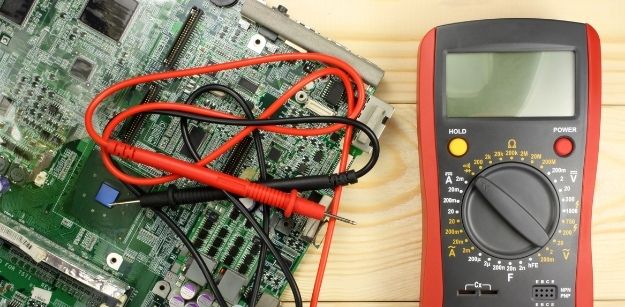When it comes to engineering equipment, often clamp meters and digital multimeters are difficult for newbies in electrical work to choose between.
While both electrical instruments test current, voltage, resistance, capacitance, and other electrical parameters, clamp meters and digital multimeters have distinct characteristics. A clamp metre is a current measuring electrical instrument with some voltage measuring capabilities, whereas a digital multimeter is used chiefly to detect voltage but can also measure current.
Still, deciding between these electrical instruments is complex, which is why as electrical instrument experts, we wrote this article. To provide you with an overview of both metre kinds as well as suggestions on which tool is better to use in terms of aesthetics, measurements, accuracy, and safety.
What is a Clamp Meter?
A clamp metre is an electrical instrument that detects electrical problems and measures current. You might be able to get a clamp metre that does a number of electrical measures depending on the type you buy, but the primary purpose of a clamp metre is to measure current.


Advanced clamp meters can check for continuity, capacitance, and frequency, among other things. These high-quality engineering equipment versions will, of course, be more expensive than the simple clamp metre. Despite the fact that more costly clamp devices can test more measures than the basic clamp models, they are still not as precise as a digital multimeter.
In general, clamp metres are suitable for general applications that require less precision. Those unfamiliar with electrical currents may prefer the clamp metre because it is the safest option of the two electrical instruments. Overall, the clamp metre is excellent engineering equipment for measuring current when accuracy is not critical.
What is a Digital Multimeter?
A digital multimeter offers more detailed findings for a more extensive range of electrical measurements. Digital multimeters can detect voltage, ohms, and amps, but some newer models can measure down to millivolts, milliohms, and milliamperes. This enables digital multimeters to provide exact measurements, ideal for professional engineering equipment usage and environments requiring enhanced accuracy.


Even though digital multimeters are less safe than clamp metres, engineering experts and individuals seeking precise results should choose a digital multimeter over a clamp metre.
Multimeters are divided into two categories: analogue and digital. Analog metres are less costly and less accurate than digital metres. Digital multimeters, on the other hand, provide more exact measurements and testing than analogue multimeters but are a more costly electrical instrument.
Safety: Clamp Meter Vs. Digital Multimeter
Clamp metres are incredibly safe electrical instruments to use since they do not really touch the electric currents. Simply place the tool on the insulated wire’s exterior, which significantly decreases the risk of electrocution.
On the other hand, because the user must directly connect the wires to the electrical current with a digital multimeter, usage is less safe than a clamp metre. Users are more likely to get electrocuted or injured as a result of this electrical instrument. Therefore, this engineering equipment tool requires extreme caution and attention from the user as it may be quite hazardous.
Design: Clamp Meter Vs. Digital Multimeter
A clamp metre is a handheld electrical instrument with a body that clamps around the wire and contains sensors on the end. The clamp metre design is quite similar to the multimeter, but the clamp at the end is the only difference, making this engineering equipment extremely user-friendly and portable.
Similarly, digital multimeters are also handheld engineering instruments, allowing the user to hold the electrical instrument in one hand while testing the electrical wire’s readings. A digital multimeter comes with two wires that connect to the measuring circuit, and it does not have any clamps at the end, unlike the clamp metre.
Measurement and Accuracy: Clamp Meter Vs. Digital Multimeter
The majority of clamp metres can measure currents up to 10A. If you exceed that limit, you run the danger of blowing an internal fuse. However, more costly models could have plug-in attachments that let you measure larger amps.
The clamp metre does not have the same precision as a digital multimeter when it comes to accuracy because the electrical instrument never encounters the real current – so it can’t be as precise. Nonetheless, clamp meter findings are reliable enough for every day engineering equipment usage.
Whereas a digital multimeter gives extremely precise voltage, ohms, and amperes readings. In addition, multimeter measurements may be constructed to provide more accuracy by measuring the millivolt, milliohm, and milliampere in more recent designs.
High-end multimeters do more testing in general – including temperature, inductance, capacitance, frequency, relative humidity, and acidity testing – making digital multimeters more precise than clamp metres. As a result, digital multimeters are extraordinarily adaptable electrical instruments and suitable for a wide range of applications.
Price: Clamp Meter Vs. Digital Multimeter
In terms of electrical instruments, both clamp metres and digital multimeters cost around the same price. However, multimeters are somewhat more expensive than clamp metres since they are more accurate and test a broader range of measures.
In addition, depending on the model, the electrical instrument price will be higher if the device’s readings are more accurate readings and have a more extensive measuring range. You should expect to pay more money for more precise engineering equipment; a high-end model will set you back a significant sum of money.
Best Application Use: Clamp Meter Vs. Digital Multimeter
Since a clamp meter has lower accuracy and enhanced safety measures, this electrical instrument is most ideal for general current testing around the house. In contrast, professional work environments which demand accurate results will require something more precise than a clamp metre.
When you require a range of tests with exact results, digital multimeters are the way to go. Cowley Electrical Ulladulla explains that electricians and other professionals should get a quality digital multimeter since they can frequently test a range of current characteristics.
Those who want to use a digital multimeter to merely measure currents throughout their house should exercise caution because it is more hazardous than the clamp metre.
Final Verdict: Is a Clamp Meter or Digital Multimeter Better?
Neither the clamp metre nor the digital multimeter is intrinsically superior, as there are instances when one electrical instrument should be preferred over the other. In a nutshell, users will have to choose a metre depending on the intended application and required accuracy levels.
Clamp metres and multimeters were once two distinct electrical instruments, but increasingly contemporary appliances have blurred the boundary between the two. If you believe you require both, it may be worthwhile to seek a contemporary device that accommodates both measurements.
Although less precise than a high-end multimeter, these contemporary instruments are a wonderful way to obtain the best of both electrical instruments.
If you’re an electrician or want to use this engineering equipment professionally, you should probably invest in a contemporary gadget and a reliable digital multimeter. Having both on hand ensures that you have the right tool for the job at all times.
Source Your Next Electrical Instruments at a Reputable Electrical Instruments Supplier
No matter if you need a clamp meter or digital multimeter for hobbyist requirements or professional applications, a reputable electrical instruments supplier stocks an extensive inventory of high-powered electrical instruments from industry-leading suppliers to suit any customer and engineering equipment requirements.



